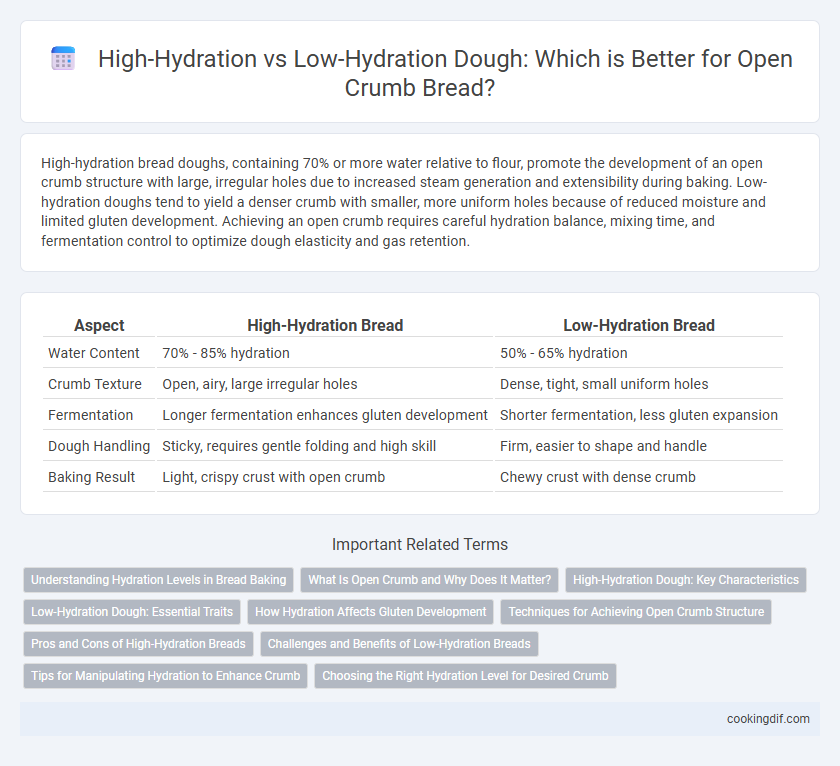High-hydration bread doughs, containing 70% or more water relative to flour, promote the development of an open crumb structure with large, irregular holes due to increased steam generation and extensibility during baking. Low-hydration doughs tend to yield a denser crumb with smaller, more uniform holes because of reduced moisture and limited gluten development. Achieving an open crumb requires careful hydration balance, mixing time, and fermentation control to optimize dough elasticity and gas retention.
Table of Comparison
| Aspect | High-Hydration Bread | Low-Hydration Bread |
|---|---|---|
| Water Content | 70% - 85% hydration | 50% - 65% hydration |
| Crumb Texture | Open, airy, large irregular holes | Dense, tight, small uniform holes |
| Fermentation | Longer fermentation enhances gluten development | Shorter fermentation, less gluten expansion |
| Dough Handling | Sticky, requires gentle folding and high skill | Firm, easier to shape and handle |
| Baking Result | Light, crispy crust with open crumb | Chewy crust with dense crumb |
Understanding Hydration Levels in Bread Baking
High-hydration dough, typically containing 70% or more water relative to flour weight, promotes an open crumb structure by increasing gas retention and gluten development. Low-hydration doughs, usually below 60% water, result in denser bread with a tighter crumb due to less extensible gluten networks. Mastering hydration levels is crucial for bakers targeting specific crumb textures, balancing water absorption with flour type and mixing methods.
What Is Open Crumb and Why Does It Matter?
Open crumb in bread refers to a porous, airy interior with irregular holes, often desired for its light texture and enhanced flavor profile. High-hydration doughs, containing 70% or more water relative to flour weight, promote gluten development and gas retention, resulting in a more open crumb structure compared to low-hydration doughs under 60%. Achieving an open crumb is crucial for artisan breads like ciabatta and sourdough to ensure optimal mouthfeel and digestibility.
High-Hydration Dough: Key Characteristics
High-hydration dough, typically containing 70% to 85% water relative to flour weight, produces an open crumb with large, irregular holes due to its increased extensibility and gas retention. This dough's elevated moisture content enhances gluten development and fermentation activity, resulting in a moist, airy texture and a crisp crust. Bakers often prefer high-hydration dough for artisan breads like ciabatta and baguettes to achieve a distinctive open crumb structure and improved flavor complexity.
Low-Hydration Dough: Essential Traits
Low-hydration dough, typically containing 55-60% water relative to flour weight, produces a denser crumb structure with smaller, uniform air pockets. This dough type offers improved handling and scoring precision, making it ideal for breads requiring a tight, consistent crumb such as sandwich loaves or bagels. The limited water content results in a firmer dough that retains shape well but yields less pronounced oven spring compared to high-hydration doughs.
How Hydration Affects Gluten Development
High-hydration dough allows gluten strands to fully hydrate and align, resulting in a more extensible and elastic network that traps gas bubbles effectively, creating an open crumb structure. In contrast, low-hydration dough produces denser gluten development, leading to a tighter crumb with smaller air pockets. Optimal hydration levels, typically above 70%, are crucial for achieving the desired open crumb in artisanal breads like ciabatta and sourdough.
Techniques for Achieving Open Crumb Structure
Techniques for achieving an open crumb structure in bread vary significantly between high-hydration and low-hydration doughs. High-hydration doughs, typically ranging from 75% to 85% water content, require gentle folding and minimal degassing to preserve gas bubbles, creating large, irregular holes characteristic of an open crumb. In contrast, low-hydration doughs around 60% to 65% rely on extensive kneading and precise fermentation control to develop strong gluten networks, enhancing gas retention and crumb openness despite lower moisture levels.
Pros and Cons of High-Hydration Breads
High-hydration breads typically contain 75% or more water relative to flour, resulting in an open crumb with large, irregular holes prized in artisan bread such as ciabatta or focaccia. The increased water content enhances gluten development and fermentation, producing a moist, airy texture but requires advanced handling skills to manage sticky dough and prevent collapse. Conversely, high hydration can lead to longer baking times and may pose challenges in shaping, making low-hydration doughs more suitable for beginners seeking uniform crumb and simpler handling.
Challenges and Benefits of Low-Hydration Breads
Low-hydration breads typically range from 50% to 60% water content, resulting in a denser crumb structure with less openness compared to high-hydration counterparts. These breads offer better shaping control, reduced stickiness during handling, and longer shelf life due to lower moisture content, which helps prevent spoilage. Challenges include achieving desirable crumb softness and avoiding overly heavy texture, requiring precise fermentation and kneading techniques to optimize gluten development despite limited hydration.
Tips for Manipulating Hydration to Enhance Crumb
High-hydration doughs, typically containing 70% to 85% water relative to flour weight, promote an open crumb with large, irregular holes by increasing gluten extensibility and gas retention. Low-hydration doughs below 65% produce a denser crumb with smaller holes but offer better control during shaping and scoring. Gradually increasing hydration while using techniques like stretch-and-fold, extended fermentation, and proper autolyse can enhance bread crumb openness without sacrificing dough strength.
Choosing the Right Hydration Level for Desired Crumb
High-hydration bread doughs, typically above 75% water content, produce an open crumb with large, irregular holes ideal for artisan-style loaves like ciabatta and focaccia. Low-hydration doughs, with water levels around 60-65%, result in a denser crumb structure, suitable for sandwich breads and rolls that require a tighter texture. Selecting the appropriate hydration depends on the desired crumb openness, flour type, and baking technique to achieve optimal texture and flavor.
High-hydration vs low-hydration for open crumb Infographic

 cookingdif.com
cookingdif.com